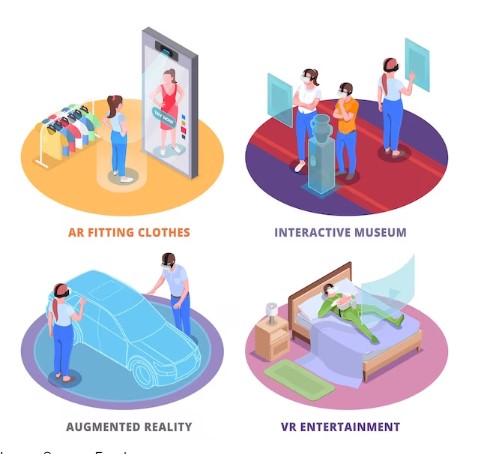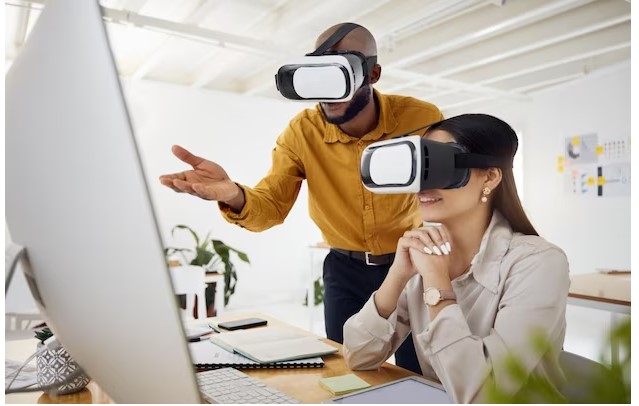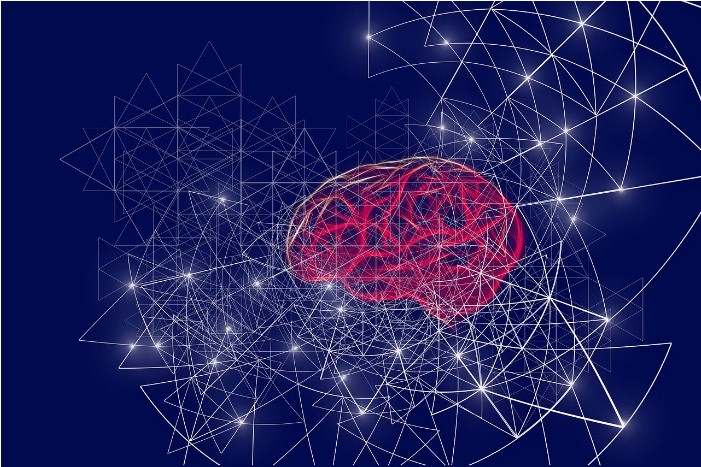Leveraging Augmented Reality for Skill Development
Introduction
In today’s rapidly evolving world, staying ahead and acquiring new skills are essential for personal and professional growth. With traditional learning methods struggling to keep up with the increasing demand for immersive and interactive experiences, augmented reality (AR) has emerged as a game-changing tool for skill development.
Leveraging the power of AR, individuals can now step into virtual worlds, explore different scenarios, and practice complex tasks in a safe and controlled environment. From medical training simulations to enhancing technical expertise in engineering, AR is revolutionizing the way we learn and acquire skills.
With its ability to blend the physical and digital worlds seamlessly, AR provides an engaging and captivating learning experience. By overlaying digital information onto real-life environments, learners gain a deeper understanding and quickly grasp complex concepts.
Not only does AR improve knowledge retention, but it also boosts motivation and learner engagement. The ability to interact with virtual objects and receive real-time feedback fosters a sense of accomplishment and encourages active participation.
The Benefits of Using Augmented Reality for Skill Development
Augmented reality offers numerous benefits for skill development. Firstly, AR provides a highly immersive learning experience that allows individuals to practice real-world tasks in a virtual environment. This helps in building muscle memory and developing practical skills without the need for physical resources or risking any potential harm or damage.
Secondly, AR enables learners to explore scenarios that would otherwise be difficult or impossible to replicate in the real world. For example, medical professionals can simulate complex surgeries or emergency situations, allowing them to gain valuable experience and confidence.
Additionally, AR enhances collaboration and teamwork by enabling multiple users to interact in the same virtual space. This is particularly useful for fields such as architecture or engineering, where teams can visualize and manipulate 3D models together, fostering creativity and innovation.
Furthermore, AR offers personalized learning experiences by adapting to individual needs and preferences. Learners can progress at their own pace and receive targeted feedback to improve their skills. This customization ensures that the learning process is efficient and effective.
In summary, the benefits of using AR for skill development include immersion, realistic simulations, enhanced collaboration, and personalized learning experiences.
Case Studies of Successful AR Skill Development Programs
Several organizations have successfully implemented AR skill development programs, showcasing the effectiveness of this technology. One notable example is the use of AR by the military for training purposes. Soldiers can practice combat scenarios and learn tactical strategies in a safe and controlled environment, improving their skills and decision-making abilities on the battlefield.
Another case study is the application of AR in the aviation industry. Pilots can use AR headsets to overlay flight data and instrument readings onto their field of view, providing real-time information and enhancing situational awareness. This improves their ability to navigate and respond to various flight conditions, ultimately leading to safer and more efficient flights.
Furthermore, AR has been utilized in the healthcare sector for training medical professionals. Surgeons can practice complex procedures using AR simulations, allowing them to refine their techniques and minimize the risk of errors during actual surgeries. This technology also enables healthcare practitioners to visualize patient data and medical images in real-time, aiding in diagnosis and treatment planning.
These case studies demonstrate the versatility and effectiveness of AR in skill development across different industries.
How to Incorporate AR into Skill Development Training
To incorporate AR into skill development training, organizations need to follow a systematic approach. The first step is to identify the specific skills that require development and determine how AR can enhance the learning process.
Once the target skills are identified, organizations can design AR experiences that align with the learning objectives. This involves creating virtual environments and scenarios that simulate real-world situations, allowing learners to practice and apply their skills.
It is crucial to ensure that the AR experiences are user-friendly and intuitive. Clear instructions, interactive elements, and user-friendly interfaces contribute to a seamless and engaging learning experience.
Organizations should also consider the hardware requirements for implementing AR. Depending on the complexity of the AR experiences, learners may need access to smartphones, tablets, or specialized AR devices such as headsets or glasses. Providing the necessary equipment and ensuring its compatibility is essential for a successful implementation.
Furthermore, organizations should develop relevant assessments and feedback mechanisms to evaluate learners’ progress and provide constructive feedback. This helps in measuring the effectiveness of the AR training program and identifying areas for improvement.
Overall, incorporating AR into skill development training requires careful planning, design, and evaluation to maximize its impact.
The Role of AR in Enhancing Learning and Retention
AR plays a significant role in enhancing learning and retention by providing a multi-sensory and interactive learning experience. Traditional learning methods often rely on passive consumption of information, leading to lower retention rates. However, AR engages learners actively and stimulates multiple senses, resulting in improved knowledge retention.
By allowing learners to interact with virtual objects and manipulate digital information, AR promotes active learning. This hands-on approach fosters a deeper understanding of concepts and encourages learners to explore and experiment.
Furthermore, AR provides immediate feedback, enabling learners to correct their mistakes and reinforce correct behaviors. This real-time feedback loop enhances the learning process and helps learners develop the right skills and techniques.
Moreover, the immersive nature of AR experiences creates a memorable and impactful learning environment. Learners are more likely to remember information and skills acquired through AR due to the emotional and sensory engagement associated with the technology.
Overall, AR enhances learning and retention by promoting active engagement, providing immediate feedback, and creating a memorable learning experience.
Challenges and Limitations of Using AR for Skill Development
While AR offers numerous benefits, there are also challenges and limitations that organizations need to consider when implementing AR for skill development.
One challenge is the cost associated with developing and maintaining AR applications. Creating high-quality AR experiences requires skilled developers and designers, as well as the necessary hardware and software infrastructure. This can be a significant financial investment for organizations, particularly for smaller businesses or educational institutions with limited resources.
Another challenge is the need for continuous updates and improvements. As technology evolves, AR experiences may become outdated or incompatible with newer devices or operating systems. Organizations must allocate resources for ongoing maintenance and updates to ensure the longevity and relevance of their AR skill development programs.
Furthermore, the learning curve associated with using AR devices and applications can be a barrier for some learners. Not everyone is familiar with AR technology, and there may be a need for additional training or support to ensure learners can fully utilize the AR experiences.
Lastly, there are ethical considerations related to privacy and data security when using AR. Organizations must ensure that user data is protected and that AR experiences comply with privacy regulations to maintain trust and confidence in the technology.
Despite these challenges, organizations can overcome them by careful planning, resource allocation, and user support.
Best Practices for Implementing AR in Skill Development Programs
To ensure successful implementation of AR in skill development programs, organizations should follow these best practices:
- Clearly define the learning objectives: Identify the specific skills that need to be developed and align the AR experiences with the desired learning outcomes.
- Design user-friendly and intuitive AR experiences: Ensure that the AR applications are easy to use and navigate, with clear instructions and interactive elements.
- Provide adequate training and support: Offer comprehensive training and support for learners to familiarize themselves with the AR technology and maximize its potential.
- Regularly update and maintain AR applications: Allocate resources for ongoing updates and maintenance to keep the AR experiences up-to-date and compatible with the latest devices and operating systems.
- Evaluate and measure the effectiveness of the AR training program: Implement assessments and feedback mechanisms to evaluate learners’ progress and identify areas for improvement.
By following these best practices, organizations can optimize the benefits of AR in skill development and ensure a seamless learning experience for their workforce.
Tools and Technologies for Creating AR Skill Development Experiences
Several tools and technologies are available for creating AR skill development experiences. These tools provide a range of features and functionalities to design and develop immersive AR applications.
One popular AR development platform is Unity. Unity offers a comprehensive set of tools and resources for creating interactive and visually appealing AR experiences. It supports various hardware platforms, including smartphones, tablets, and specialized AR headsets.
Another notable tool is Vuforia, which provides advanced computer vision capabilities for creating marker-based AR applications. Vuforia enables developers to recognize and track real-world objects, allowing users to interact with virtual content in a more contextualized manner.
Moreover, ARKit and ARCore are software development kits (SDKs) provided by Apple and Google, respectively. These SDKs enable developers to build AR applications specifically for iOS and Android devices. They offer features such as motion tracking, environmental understanding, and light estimation, enhancing the realism and immersion of AR experiences.
Additionally, 3D modeling and design software, such as Autodesk Maya or Blender, can be utilized to create digital assets and virtual environments for AR applications. These tools allow designers to create realistic 3D models and animations, enhancing the visual quality of the AR experiences.
These tools and technologies provide a solid foundation for creating engaging and interactive AR skill development experiences. Organizations can choose the most suitable tools based on their specific requirements and budget constraints.
Examples of Industries Using AR for Skill Development
AR is being utilized across various industries for skill development purposes. Here are a few examples:
- Healthcare: Medical professionals can use AR simulations to practice surgeries, learn anatomy, and improve diagnostic skills. AR also enables the visualization of patient data and medical images, aiding in treatment planning and collaboration among healthcare practitioners.
- Manufacturing: AR can be used to train employees in assembly line processes, equipment operation, and maintenance procedures. By overlaying digital instructions and visual cues onto real-world objects, AR simplifies complex tasks and reduces training time.
- Architecture and Construction: Architects and construction workers can use AR to visualize and manipulate 3D models of buildings, improving design accuracy and facilitating communication among stakeholders. AR also allows on-site workers to access real-time information and instructions, enhancing productivity and safety.
- Automotive: AR can assist automotive technicians in diagnosing and repairing complex vehicle systems. By overlaying digital information onto physical components, AR provides step-by-step instructions and visual aids, enabling technicians to perform tasks with greater efficiency and accuracy.
- Education: AR is transforming the way students learn by providing interactive and immersive educational experiences. Students can explore historical events, visualize scientific concepts, and engage in virtual experiments, making learning more engaging and impactful.
These examples illustrate the diverse applications of AR in skill development and its potential to revolutionize various industries.
Conclusion: The Future of AR in Skill Development
As technology continues to advance, the use of augmented reality in skill development is expected to grow rapidly. AR offers a unique and powerful tool for individuals and organizations to acquire and enhance skills in a safe, engaging, and efficient manner.
The benefits of AR for skill development, such as immersion, realistic simulations, enhanced collaboration, and personalized learning experiences, make it a valuable asset in today’s dynamic world.
While there are challenges and limitations associated with implementing AR, organizations can overcome them with careful planning, resource allocation, and user support.
As AR technology becomes more accessible and affordable, its potential to transform skill development across various industries is immense. The ability to practice and acquire skills in a virtual environment has the potential to revolutionize training programs and unlock the full potential of individuals and organizations.
In conclusion, augmented reality is a game-changing tool that is reshaping the way we learn and acquire skills. By leveraging the power of AR, individuals and organizations can stay ahead in the ever-evolving world and thrive in the digital age. The future of skill development lies in the seamless integration of AR into training programs, unlocking new possibilities and empowering learners to achieve their full potential.






